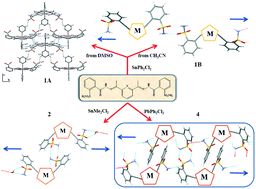Directing effects of aminosulfonyl groups on the crystal packing of tin and lead complexes†
Abstract
The pentadentate symmetrical ligand 2,5-diacetylpyridinebis-(2′-aminosulfonylbenzoyl)hydrazone (H2L), with two aminosulfonyl groups located at both ends of the ligand, was obtained and used for the preparation of diorganotin(IV) complexes, [SnR2L] R = Ph (1), Me (2), nBu (3), and a diorganolead(IV) complex, [PbPh2L] (4). The spectroscopic and structural characterization of the complexes revealed that they are all very similar, showing a bipyramidal pentagonal coordination around the metal atom, with the pentadentate chelating ligand (L2−) in the equatorial plane. It was possible to study two crystal structures of compound 1 (1A and the acetonitrile solvate 1B) and of compounds 2 and 4. The analysis of the packing of the four crystal structures revealed that the aminosulfonyl groups, not involved in the coordination to the metal center, show directing effects that influence the crystal packing of the compounds. Thus, the coordination of the deprotonated ligand (L2−) to the metal as a planar [N3O2] chelate places both aminosulfonyl groups at the open end of the ligand, on opposite sides, favoring the propagation of intermolecular interactions that involve these groups.


 Please wait while we load your content...
Please wait while we load your content...